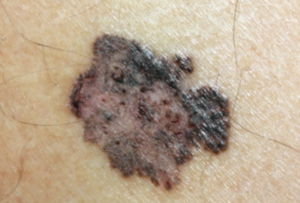
“Yes, there is always a chance for ‘regression’ for both normal mole and melanoma,” says Dr. Tess Mauricio, MD, FAAD, a leading board certified dermatologist from Stanford University Medical School and CEO of MBeautyClinic.com.
“Regression is a normal body process that happens in melanoma,” continues Dr. Mauricio.
“It is a little bit of a mixed blessing with melanoma because the body is getting rid of melanoma, but you may never know the depth of a melanoma-primary if it has extensive regression.”

Melanoma showing signs of regression.
If you don’t inspect your skin thoroughly once a month, you can easily miss the development of melanoma and then its disappearance over time.
You’ll never know that “that bad mole” was there. But out of sight doesn’t mean out of body.
The melanoma or suspicious looking mole may have disappeared only as far as what your naked eye could detect.
What makes a melanoma spontaneously go away?
“The body’s own immune system can cause regression,” says Dr. Mauricio.
“But it can disappear only on the surface and what we can see. There may still be melanoma cells under the skin that can spread and metastasize.”
Worse, it may have already spread. “This is one of the theories on patients who are diagnosed with metastatic melanoma without a primary site.”
For instance, a brain tumor or lung mass is discovered. Testing reveals metastatic melanoma.
However, a vigorous check of the patient’s body can’t locate the original or primary spot (pigmented lesion) from which the cancer cells broke off and migrated to take up real state in the brain or lungs.
The phenomenon of melanoma spontaneously disappearing due to the body’s recognition that it doesn’t belong there will backfire if you do not thoroughly examine your skin on a monthly basis.
Don’t ever think, “Hmm, that weird looking mole is beginning to go away. I guess I no longer need to worry.”
If it’s melanoma, it’s disappearing only from your naked eye vision.
Benign Vanishing
If you just happen to notice that a longstanding and always-normal-looking mole has begun fading very gradually over a long period of time, this is most likely a normal process reflecting the lifecycle of a mole.
Sometimes, a normal mole will just fade away over time.
A dermatologist can confirm this by inspecting the mole with a handheld lens, though sometimes a biopsy will be offered to give the patient peace of mind.
The more you get to know as many of your moles as possible, the more likely you’ll catch what may seem to be an evolutionary process of melanoma and an eventual disappearance of it, vs. the much more gradual fading of benign moles.
 Dr. Mauricio is an internationally recognized cosmetic surgeon and the youngest woman to hold the position of President of The San Diego Society for Dermatologic Surgery.
Dr. Mauricio is an internationally recognized cosmetic surgeon and the youngest woman to hold the position of President of The San Diego Society for Dermatologic Surgery.
 Lorra Garrick has been covering medical, fitness and cybersecurity topics for many years, having written thousands of articles for print magazines and websites, including as a ghostwriter. She’s also a former ACE-certified personal trainer.
Lorra Garrick has been covering medical, fitness and cybersecurity topics for many years, having written thousands of articles for print magazines and websites, including as a ghostwriter. She’s also a former ACE-certified personal trainer.
.









































